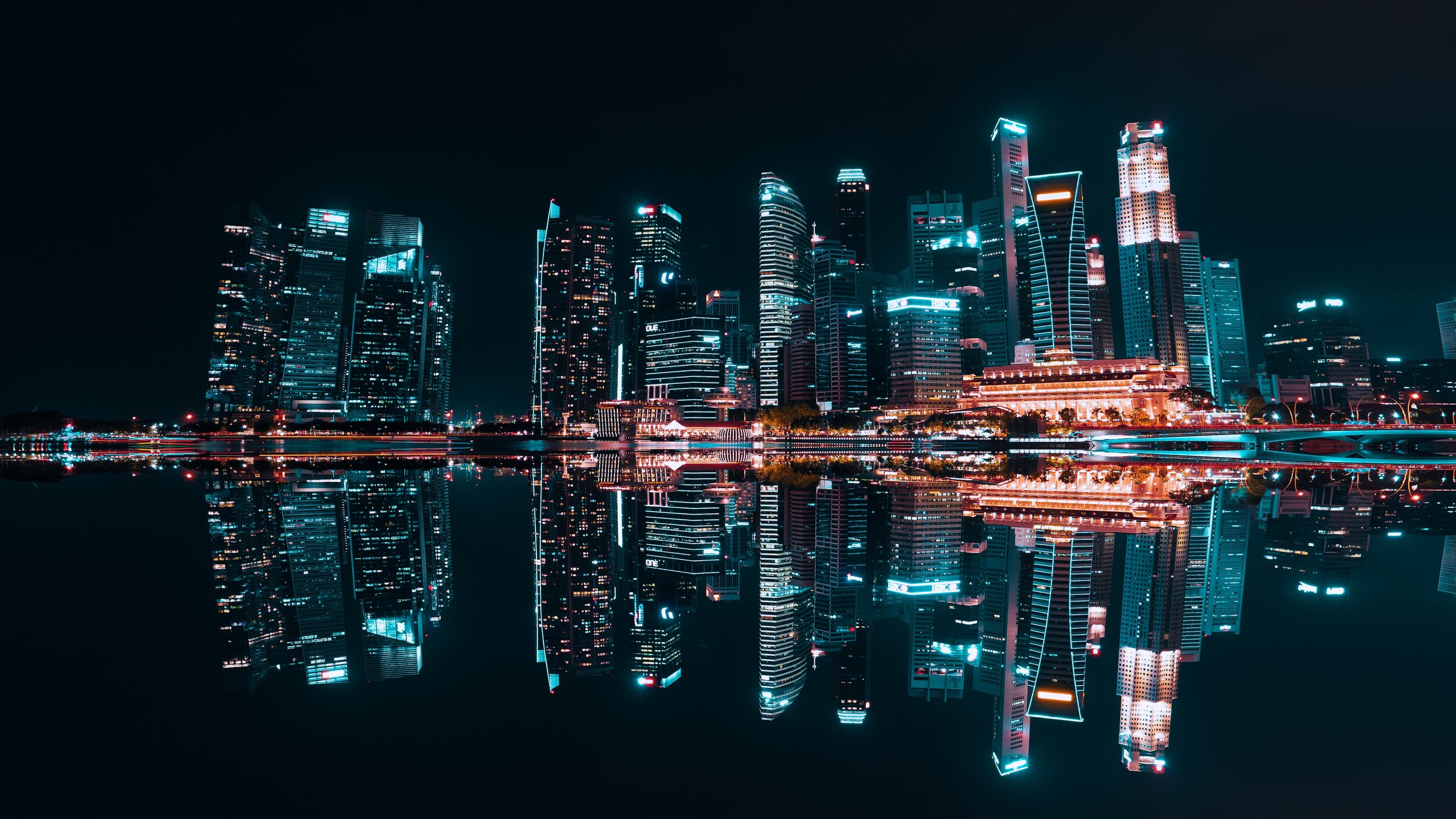Midnight, Water City

Yes, things are a little different in Hawai‘i in the year 2142. But some things never change; society is still divided into The Money, The Less Thans and the OBB, for Octogenarian Boredom on a Budget. And there still are times when only a cynical detective will do, such as now, in the hours following the murder of the woman who saved the world, scientist Akira Kimura.
Chapter 7
I’m flying at top speed above the ocean.
Looking down at the pleats of breaking water, I am amazed at how well-organized something as chaotic as the sea can look from afar. I break to the west side of the island and dip down to the well-lit coast. Seascraper cabana beach caps to the right, the giant aquatic theme park connected to the beach, shaped like a giant oyster with a pearl-like dome in the middle. Golf courses. A couple of shabby ones for the OBB, the rest exclusively for The Money.
This side of the island is where a few of The Money live, the older ones who prefer land under their feet, who own prime acreage cut from lava rock fronting vast manmade white sandy beaches. I’m gliding over the estate of Idris Eshana, inventor of the iE. He died a few years back at 121. His château is being converted to a museum, soon to be another stop on The Savior’s Eye pilgrimage. It’s next to the shuttlefield where people transport to the continents and other faraway water cities. The whole scene probably looks like any point in the history of civilization, really, the past smeared with the present.
I remember that when Sabrina and I first started dating, she was in awe of the people I knew. Of course, there was Akira, but when this island became the center of the world, I also knew top brass like NASA Director Parker and tech moguls like Idris Eshana, who came to help plan the construction of Ascalon. This is when a lot of The Money showed up to try to pitch in, or if their help was turned away, to witness. After Ascalon did her thing, a lot of The Money ended up staying. The island is conveniently located between the Mainland US and Asia, the world’s two financial, recycling, and tech giants.
I stayed friends with some of these people. I may have even saved a couple of them back in the day, when zealots came and tried to blow up the entire mission. The crazies who believed that the apocalypse was meant to be. Sabrina heard old Idris tell the story of me pulling out my rail gun and seemingly firing at random into a crowd of protesters. My own security team thought I had gone crazy and almost gunned me down. The truth is, I fired once. And it wasn’t random. I saw green. And the kid I shot was packing a dirty bomb in his backpack. But to hear Idris tell it, I performed like an action hero, and Sabrina was smitten. Idris winked at me after she walked away. Nothing like having the richest man in the world wingman you.
It’s easy to drift into nostalgia up here in a SEAL. Not many fly them, so there’s never really traffic. SEAL licenses are only granted to first responder, military, and science personnel, and even then, you need to be of a certain rank. I own mine, but I put it up for collateral to buy the float burb unit, so who knows for how much longer. Kind of like me, it’s becoming obsolete anyway. There aren’t really serviceable roads on the island anymore, and vac tube trains, hovers, and heli-taxis get everybody where they need to go. The Money still have their SEALS and employ ex-cops and ex-military like me to chauffeur them around, dangling supplemental pension and all, but even they hardly use military-grade flying vehicles anymore. We just don’t gotta go that high.
Maybe I’m feeling weepy about the past because of the death of my best friend. Maybe it’s the mess I just made back home. But most likely it’s because I’ve called in a couple of favors from The (old) Money pals, and it’s always been painful for me to ask anybody for anything. Another of my personal flaws that eighty years of supposed learning never stomped out.
I’m hovering over a prepubescent sweep of native trees now, a forest once wiped out and then replanted. They take three hundred years to hit full, majestic maturity, so these are just twenty-foot saplings that are about my age.
I’m heading to see Jerry Caldwell, a retired attorney from Mile High who’s also one of the heirs to the biggest corn syrup company in the world. Like Big Tobacco before it, the industry took a giant hit in the US when there was outcry that these companies were knowingly poisoning the children of the nation with GMO junk food. And like Big Tobacco, her family’s company simply concentrated production and sales abroad and continued to thrive by poisoning foreign children in countries who supposedly weren’t as free as in the US, but let their people poison themselves all they wanted. Jerry came here with her parents when the rest of The Money did, offering to throw their fortune into the Ascalon Project. But they were among the rejected who ended up just staying in their brand-new deep-sea lofts to watch.
Akira was downright mean about it to Jerry’s father—the thought makes me laugh to this day. What she said to one of the richest men in the world was, “What are you proposing we do? Bribe a carbonaceous chondrite meteorite with a carbonated beverage and ask it to smile and go away?” The old man never got over the insult. But like everyone else, he stayed for the show.
Jerry and I go way back. I actually met her through Akira. They’d gone to grad school together on the East Coast. Princeton-Columbia U. After Akira finished her undergrad degree in Japan, she split and went on to do her PhD in astrophysics. Jerry was a freshman at the time, double majoring in physics and economics.
There are thousands of books on Akira’s life, but most concentrate on the crazy days of Sessho-seki, while others attempt to recreate her experiences as a childhood genius. Her piano story has been written hundreds of times, on the same level as Newton and his apple at this point. But none of the biographies delve into Akira’s college days, when she was actually learning. People aren’t into that sort of thing. They want to know what was going on when someone was doing, not learning. Besides, Akira has always been a private person. Jerry, too. So any recounting of this time in Akira’s life is speculation. And despite the fact that Akira and Jerry were best friends in college, Jerry taking this tween under her wing, hardly any of these books mention Jerry at all.
When the world was ending, Akira hired her old PCU friend as one of her attorneys. Insult to injury for Jerry’s old man. But a couple years later, they had a falling out over what Jerry called Akira’s “psychopathic ego.” She added that if it weren’t for the fact that Akira had to live on this planet, she’d have had zero interest in saving it. I found this hilarious. There was probably some truth to it, but Jerry was bruised over the whole thing. Akira, on the other hand, seemed completely indifferent, which was consistent with how Jerry saw her.
It’s weird having two close friends who hate each other, but neither ever seemed to mind that I hung out with the other, unless you counted silent judgment.
Jerry’s the one I called to get me released from interrogation. But I’m not heading to her place now to discuss the case or Akira and the bad old days. I just need a couch to crash on, which through forty years and two wives, Jerry has always provided. She lives on the next island over, the one packed with skyscrapers built by all the rejected Money years back, years after the Great Sun Storm, when storms in general were the least of our concern. The entire place is lit up and reaches into the sky, cloud-breaking bouquets of tech mounted with telescopes that each resident can patch into from the comfort of their high-altitude homes. Besides Akira’s Telescope, this place offered the best bird’s-eye view to an extinction-level event. When Ascalon’s Scar first lit up the sky, some thought it was Sessho-seki coming and jumped. Human feet, broken at the ankles from impact, washed up onshore for weeks after the world was saved. A page-three story to anyone but a cop who had the task of matching feet with names while the rest of the world celebrated. It sucked, too, because we stopped keeping toeprint records by then.
My iE goes off. A reminder to take my blood pressure and anti-plaque pills. I think about my 3D-printed fake teeth, fake hips, fake hair. Neck and jowls nipped and tucked. Already on my second heart and liver, benes used up from military service. The entire thing propped up by titanium in my spine and left leg. Unlike my pain, memory, space-travel grade anti-anxiety and anti-insomnia pills, these BP and anti-plaque pills I take. This is what getting old is, expecting our second or even third livers to hold up the messes we call bodies as we weigh them down a pill at a time. I pop my pharma and descend to the ocean-generated bioluminescence that lights up the scrapers. I head toward the biggest one, the tint of the whale tail–shaped tower breaching two layers of clouds moving in opposite directions.
Copyright © 2021 Chris McKinney, from Midnight, Water City, courtesy of Soho Press. Chris McKinney’s Midnight, Water City will be published by Soho Press in July as book one of The Water City triology.
Image by Pang Yuhao.
Chris McKinney was born in Honolulu and grew up in Kahalu‘u on the island of O‘ahu. He is the author of six novels, The Tattoo, The Queen of Tears, Bolohead Row, Mililani Mauka, Boi No Good, and Yakudoshi: Age of Calamity. His seventh novel, Midnight, Water City, was released by Soho Press and distributed by Random House in July 2021. Chris has written two feature film screenplays, Paradise Broken (nominated for best film at the Los Angeles Pacific Film Festival), and Haole, which he co-executive produced (currently available on Prime Video). He has also written two short films, "The Back Door" and "Calamity," which he also co-produced.
In 2011, Chris was appointed Visiting Distinguished Writer at the University of Hawai‘i at Mānoa. Over the years, he has won one Elliot Cades Award and seven Kapalapala Po‘okela Awards. His first novel, The Tattoo, represents Hawai‘i on Quiklit's 50 States, 50 Novels: A Literary Tour of the United States.





